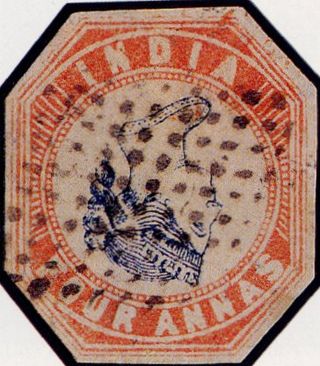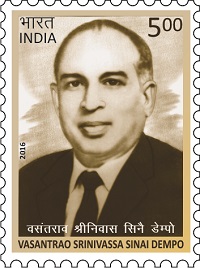1947
| # | Issue Date | Description | Image | Denomination |
|---|---|---|---|---|
| 1 | 21 November 1947 | National Flag of India |  | 3½ anna |
| 2 | 15 December 1947 | Ashoka Lion Capital |  | 1½ anna |
| 3 | 15 December 1947 | Aircraft |  | 12 anna |
This is a list of commemorative postage stamps issued by the India Post between 1947 and 1950.
| # | Issue Date | Description | Image | Denomination |
|---|---|---|---|---|
| 1 | 21 November 1947 | National Flag of India |  | 3½ anna |
| 2 | 15 December 1947 | Ashoka Lion Capital |  | 1½ anna |
| 3 | 15 December 1947 | Aircraft |  | 12 anna |
| # | Issue Date | Description | Image | Denomination |
|---|---|---|---|---|
| 1 | 29 May 1948 | Air India International |  | 12 anna |
| * | Mahatma Gandhi (Set of 4 Stamps) | |||
| 2 | 15 August 1948 | Mahatma Gandhi |  | 1½ anna |
| 3 | 15 August 1948 | Mahatma Gandhi |  | 3½ anna |
| 4 | 15 August 1948 | Mahatma Gandhi |  | 12 anna |
| 5 | 15 August 1948 | Mahatma Gandhi |  | 10 Rs anna |
| # | Issue Date | Description | Image | Denomination |
|---|---|---|---|---|
| * | 75th Anniversary of formation of Universal Postal Union | |||
| 1 | 10 October 1949 | Universal Postal Union | | 9 pies |
| 2 | 10 October 1949 | Universal Postal Union | | 2 anna |
| 3 | 10 October 1949 | Universal Postal Union | | 3½ anna |
| 4 | 10 October 1949 | Universal Postal Union | | 12anna |
| # | Issue Date | Description | Image | Denomination |
|---|---|---|---|---|
| * | Inauguration of Republic of India (Set of 4 Stamps) | |||
| 1 | 26 January 1950 | Rejoicing Crowds | | 2 anna |
| 2 | 26 January 1950 | Quill, Ink-well and Verse |  | 3½ anna |
| 3 | 26 January 1950 | Corn and Plough | | 4 anna |
| 4 | 26 January 1950 | Charakha and Cloth | | 12anna |

A postage stamp is a small piece of paper issued by a post office, postal administration, or other authorized vendors to customers who pay postage. Then the stamp is affixed to the face or address-side of any item of mail—an envelope or other postal cover —which they wish to send. The item is then processed by the postal system, where a postmark or cancellation mark—in modern usage indicating date and point of origin of mailing—is applied to the stamp and its left and right sides to prevent its reuse. Next the item is delivered to its addressee.

Indian postal systems for efficient military and governmental communications had developed long before the arrival of Europeans. When the Portuguese, Dutch, French, Danish and British conquered the Marathas who had already defeated the Mughals, their postal systems existed alongside those of many somewhat independent states. The British East India Company gradually annexed the other powers on the sub-continent and brought into existence a British administrative system over most of modern-day India, with a need to establish and maintain both official and commercial mail systems.

The native states of India, also known as feudatory or princely states, were typically vassals under a local or regional ruler who owed allegiance to the British Raj. There were about 675 native states in all but many were not parts of British India proper because they never become possessions of the British Crown; rather, they were tied to it in a system of subsidiary alliances. Following the Partition of India in 1947, the suzerainty of the Raj was terminated and native states had to choose between independence or formal accession by either India or Pakistan. In practice, all of the native states had acceded or been annexed by the end of 1949.

The postal history of Portuguese India goes back to the earlier days of the colony. The postal history begins with communication between the Viceroy and the Court at Lisbon soon after the conquest of Old Goa by Afonso de Albuquerque in 1510. Letters, written in triplicate, were carried by separate ships because of the hazards of the voyage. Mail was carried by an overland route, as well. The early communications of Portuguese India had an official character and the correspondence is now to be found in museums and governmental and ecclesiastical archives.

Kuppalli Venkatappa Puttappa, popularly known by his pen name Kuvempu, was an Indian poet, playwright, novelist and critic. He is widely regarded as the greatest Kannada poet of the 20th century. He was the first Kannada writer to receive the Jnanpith Award.
The Straits Settlements of the Malayan Peninsula have a postal history distinct from the other Malayan areas.

India Post is an Indian government-operated postal system in India, and is the trade name of the Department of Post under the Ministry of Communications. Generally known as the Post Office, it is the most widely distributed postal system in the world. Warren Hastings had taken initiative under East India Company to start the Postal Service in the country in 1766. It was initially established under the name "Company Mail". It was later modified into a service under the Crown in 1854 by Lord Dalhousie. Dalhousie introduced uniform postage rates and helped to pass the India Post Office Act 1854 which significantly improved upon 1837 Post Office act which had introduced regular post offices in India. It created the position Director General of Post for the whole country.

Kanaka Dasa (1509–1609) was a Haridasa saint and philosopher of Dvaita Vedanta, also known as Daasashreshta Kanakadasa from present-day Karnataka, India. He was a follower of Madhvacharya's Dvaita philosophy and a disciple of Vyasatirtha. He was a composer of Carnatic music, poet, reformer and musician. He is known for his keertanas and ugabhoga, and his compositions in the Kannada language for Carnatic music. Like other Haridasas, he used simple Kannada and native metrical forms for his compositions.

A revenue stamp, tax stamp, duty stamp or fiscal stamp is a (usually) adhesive label used to designate collected taxes or fees on documents, tobacco, alcoholic drinks, drugs and medicines, playing cards, hunting licenses, firearm registration, and many other things. Typically, businesses purchase the stamps from the government, and attach them to taxed items as part of putting the items on sale, or in the case of documents, as part of filling out the form.

Aden is a city in southern Yemen. Aden's location made it a popular exchange port for mail passing between places around the Indian Ocean and Europe. When Captain S. B. Haines of the Indian Marine, the East India Company's navy, occupied Aden on 19 January 1839, mail services were immediately established in the settlement with a complement of two postal clerks and four letter carriers. An interim postmaster was appointed as early as June 1839. Mail is known to exist from 15 June 1839 although a regular postmaster was not appointed until 1857; one of the officials of the Political Agent or the civil surgeon performed the duties of postmaster for a small salary.

The Inverted Head Four Annas of India is a postage stamp prized by collectors. The 1854 first issues of India included a Four Annas value in red and blue. It was one of the world's first multicolored stamps; the Basel Dove preceded it by nine years. However, an invert error occurred during production, showing the head "upside down."

This is a survey of the postage stamps and postal history of Tibet.
This is a survey of the postage stamps and postal history of the Republic of the Union of Myanmar, formerly known as Burma.

This is a survey of the postage stamps and postal history of Spain.

Vasantrao Shrinivas Sinai Dempo was an Indian industrialist and philanthropist from Goa, who founded the Dempo Group of Industries. The mining business he founded in 1941 has now grown to include interests in shipbuilding, minerals, foods, iron and steel, education, travels and construction. He was the founder of the Dempo S.C., a popular football club based in Goa, which he nurtured after acquiring the local club, Bicholim SC. Vasantrao Dempo Reflective Chair, an endowment professorship at the Tepper School of Business of the Carnegie Mellon University is named after him and is funded by the endowment of Dempo Group. Dempo Charities Trust, the philanthropic arm of the Group runs several educational institutions in Goa. The Government of India awarded him the fourth highest civilian honour of the Padma Shri in 1991.

Anukulchandra Chakravarty, popularly known as Sree Sree Thakur, was a physician, a philosopher, a spiritual leader and the founder of Satsang, in Deoghar. He was born in a Brahmin family